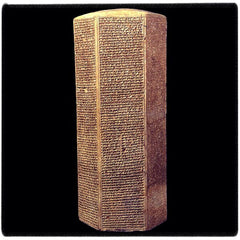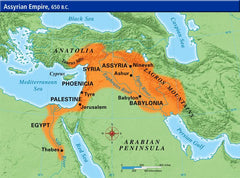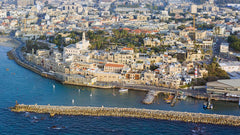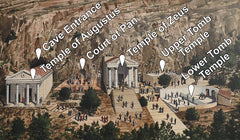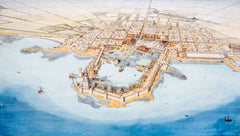Your cart is empty now.

Baptism Now Saves Us
And in so doing we shall have a better understanding of baptism and appreciation for baptism.
In 1 Peter 3 the apostle makes a comparison between the flood of Noah and baptism: “the like figure whereunto baptism doth also now save us” (v. 21). The antecedent of “whereunto” is the water of the flood in verse 20. The flood, therefore, was a type for the word “figure” in verse 21 is the Greek word “antitype.” Since the flood was the type, there is also an antitype or corresponding reality, for an antitype is the New Testament fulfillment of an Old Testament type. Already we should see that a bald reading of the text, “Baptism saves us,” will lead us astray. To understand the Spirit’s meaning here, we need to examine the relationship between the type and the antitype.
A type is an object, event, person, or action in the Old Testament that foreshadows or points to a greater reality in the New Testament. For example, David is a type of Christ; Canaan is a type of heaven; and the destruction of Sodom and Gomorrah is a type of the judgment of the wicked on the last day. The New Testament identifies two types of baptism from the Old Testament: the crossing of the Red Sea, the example expounded by Paul in I Corinthians 10; and the flood, the example explained by Peter in 1 Peter 3. There is, therefore, in these two historical events from the Old Testament something that corresponds to, points to, and foreshadows baptism in the New Testament. To understand 1 Peter 3:21, therefore, we must identify what the correspondence is.
Moreover, it is very important when studying typology to identify the point of comparison. Many violate this rule, for in typology they allow their imagination to run wild, finding typology in the Bible where there is none. Bear in mind that (1) there are only a few types, which are clearly designated as such in the New Testament; and (2) we must not seek for typology in every detail of the type. These rules are ignored; for example, if you have ever read books about the tabernacle, you will see this: expositors seeking for typology in every knop, board, and pin of the tabernacle, but missing the main point of comparison, fellowship with God in Jesus Christ!
To take the example of the flood, the fact that only eight souls were saved in the type has no corresponding reality in the antitype; the dimensions of the ark have no hidden, typological meaning; the construction of the ark from gopher wood—as opposed to any other kind of wood—is not typological; and the day, month, and year of the flood need not become an obsession for the sober exegete of God’s word. These are important historical details, but they are not part of the typology.
Finally, every Old Testament type must fail, for it is not the reality. David and Solomon, for example, are types of our Lord Jesus Christ, but they had to fail (thus, they fell into grievous sins), lest we confuse them with Jesus Christ. A type fails because it is only a foreshadowing of some greater reality. Therefore, it is not, and cannot be, the reality itself. The flood was a type of salvation, for Noah was saved through the flood, but the flood was not the salvation itself, for the waters of the flood did not cleanse Noah from sin and bring him to heaven.
Return to the words of Peter in 1 Peter 3:21: “The like figure whereunto even baptism doth also now save us.” What Peter is saying is this: the water of Noah’s flood is in some sense a type of baptism, which is a picture (a sign and seal) of salvation. Baptism saves us as the antitype—the New Testament corresponding reality—of Noah’s floodwaters.
Apply now the rules of typology to Noah’s flood.
First, what is the point of comparison between Noah’s flood and baptism? Surely, the point of comparison is water: Noah was saved by water and in baptism we are saved by water, a point that I will explain later. That might surprise the reader, for we might think that Noah was saved by the ark. Nevertheless, Peter writes, “Wherein few, that is, eight souls were saved by water, the like figure whereunto baptism now saves us…” (1 Peter 3:20–21). Noah and his family then were saved from the ungodly world by the water of the flood. Through or by means of the water of the flood, God cleansed the old world of the wicked and he separated godly, believing Noah from the ungodly inhabitants of the old world, and he brought Noah into a new world. (Similarly, through the waters of the Red Sea, God separated Israel from Pharaoh and the Egyptians, and consecrated them unto Moses, who is a type of Jesus Christ as the Mediator).
Second, where is the failure in the Old Testament type, or how is the New Testament antitype superior to the Old Testament type? The salvation of Noah by the waters of the flood was not real salvation. It did not cleanse Noah of his sins, it did not justify or sanctify Noah, and it did not bring Noah to heaven. Certainly it did great and marvelous things, for it took the wicked out the world and swept them into hell (a fearful judgment!) and by means of the flood God preserved the line of Christ in the world (it was a mighty victory of the seed of the woman over the seed of the serpent).
What about the antitype: is it baptism? Does baptism by water cleanse us from our sins, does it destroy our sinful nature, does it justify or sanctify us, and does it bring us to heaven? No, it does not. That is because baptism is not the ultimate antitype. Christ is the ultimate antitype, the fulfillment of all the Old Testament types of salvation whether the flood, the crossing of the Red Sea, the tabernacle, the sacrifices, or the reigns of David and Solomon.
With that background we are able to understand the comparison which Peter makes here and we are able to see what he means by that curious phrase “The like figure whereunto even baptism doth also now save us.”
Salvation is nothing less than full spiritual salvation from sin, death, and hell. Salvation is that work of God in delivering us from sin into the blessedness of eternal life, fellowship with God, and heaven. God saves believers and their children by forgiving them, by justifying them, by sanctifying them and making them holy, and by bringing them to the enjoyment of life with him. If that is the meaning of salvation, is Peter saying then that the sacrament of water baptism saves us? Not at all, for Peter does not say, “baptism saves us” (which is a loose paraphrase). Instead, Peter says, “the like figure whereunto even baptism doth also now save us” (v. 21). Notice the word “now”: as then the flood was typical salvation for Noah, so now baptism is salvation for us in another figure.
But we must explain this in a further blog post.
To be continued…
__________
This post was written by Rev. Martyn McGeown, missionary-pastor of the Covenant Protestant Reformed Church in Northern Ireland stationed in Limerick, Republic of Ireland. If you have any questions or comments, please post them in the comment section on the blog.
The content of the article above is the sole responsibility of the article author. This article does not necessarily reflect the opinions and beliefs of the Reformed Free Publishing staff or Association, and the article author does not speak for the RFPA.

Donate
Your contributions make it possible for us to reach Christians in more markets and more lands around the world than ever before.
Select Frequency
Enter Amount

